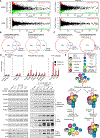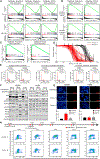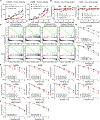RUVBL1/RUVBL2 ATPase Activity Drives PAQosome Maturation, DNA Replication and Radioresistance in Lung Cancer
- PMID: 31883965
- PMCID: PMC8048778
- DOI: 10.1016/j.chembiol.2019.12.005
RUVBL1/RUVBL2 ATPase Activity Drives PAQosome Maturation, DNA Replication and Radioresistance in Lung Cancer
Abstract
RUVBL1 and RUVBL2 (collectively RUVBL1/2) are essential AAA+ ATPases that function as co-chaperones and have been implicated in cancer. Here we investigated the molecular and phenotypic role of RUVBL1/2 ATPase activity in non-small cell lung cancer (NSCLC). We find that RUVBL1/2 are overexpressed in NSCLC patient tumors, with high expression associated with poor survival. Utilizing a specific inhibitor of RUVBL1/2 ATPase activity, we show that RUVBL1/2 ATPase activity is necessary for the maturation or dissociation of the PAQosome, a large RUVBL1/2-dependent multiprotein complex. We also show that RUVBL1/2 have roles in DNA replication, as inhibition of its ATPase activity can cause S-phase arrest, which culminates in cancer cell death via replication catastrophe. While in vivo pharmacological inhibition of RUVBL1/2 results in modest antitumor activity, it synergizes with radiation in NSCLC, but not normal cells, an attractive property for future preclinical development.
Keywords: DNA replication; RUVBL1; RUVBL2; non-small cell lung cancer; radiation therapy.
Copyright © 2019 Elsevier Ltd. All rights reserved.
Conflict of interest statement
DECLARATION OF INTERESTS
M.H., R.M., T.T., and K. I. are employees of Daiichi-Sankyo. Compound B and Compound C are patented under patent WO2015125785 by Daiichi-Sankyo. J.D.M. receives licensing royalties from the NCI and UT Southwestern for cell lines. All other authors report no conflicts of interest.
Figures







References
-
- Assimon VA, Tang Y, Vargas JD, Lee GJ, Wu ZY, Lou K, Yao B, Menon MK, Pios A, Perez KC, et al. (2019). CB-6644 is a selective inhibitor of the RUVBL1/2 complex with anticancer activity. ACS Chem. Biol. 14, 236–244. - PubMed
-
- Breig O, Bras S, Martinez Soria N, Osman D, Heidenreich O, Haenlin M, and Waltzer L (2014). Pontin is a critical regulator for AML1-ETO-induced leukemia. Leukemia 28, 1271–1279. - PubMed
-
- Centenera MM, Raj GV, Knudsen KE, Tilley WD, and Butler LM (2013). Ex vivo culture of human prostate tissue and drug development. Nat. Rev. Urol. 10, 483–487. - PubMed
Publication types
MeSH terms
Substances
Grants and funding
LinkOut - more resources
Full Text Sources
Medical
Molecular Biology Databases
Research Materials
Miscellaneous

